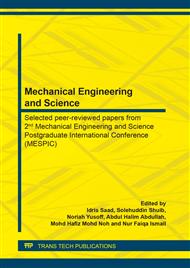[1]
N.M. Zakuan, S.M. Yusof, and A.M. Shaharoun, The link between total quality management and organizational performance in Malaysian automotive industry: The mediating role of ISO/TS16949 efforts,, IEEM 2009 - IEEE Int. Conf. Ind. Eng. Eng. Manag., p.439–443, (2009).
DOI: 10.1109/ieem.2009.5373312
Google Scholar
[2]
G. Ringena, S. Aschehouga, H. Holtskogb, and J. Ingvaldsena, Integrating quality and lean into a holistic production system,, Procedia CIRP, vol. 17, p.242–247, (2014).
DOI: 10.1016/j.procir.2014.01.139
Google Scholar
[3]
C. P. Kartha, A comparison of ISO 9000:2000 quality system standards, QS9000, ISO/TS 16949 and Baldrige criteria,, TQM Mag., vol. 16, no. 5, p.331–340, (2004).
DOI: 10.1108/09544780410551269
Google Scholar
[4]
G. P. N.M. Vaxevanidis, Z.Krivokapic, S.Stefanatos, P.Dasic, An Overview and a Comparison of ISO 9000 : 2000 Quality System Standards With Related Automotive Ones (Qs9000 , Iso / Ts 16949) and Tqm Models ( MBNQA and EFQM),, Quality, no. May, p.155–166, (2006).
DOI: 10.1108/09544780410551269
Google Scholar
[5]
S. Karapetrovic and W. Willborn, International Journal of Quality & Reliability Management,, Int. J. Qual. Reliab. Manag. TQM Mag. Iss Manag. Audit. J. Iss Manag. Audit. J., vol. 17, no. 8, p.679–703, (2004).
DOI: 10.1108/02656710010315256
Google Scholar
[6]
M. Holweg, The genealogy of lean production,, (2006).
Google Scholar
[7]
H. Hernandez, Quality audit as a driver for compliance to ISO 9001:2008 standards,, TQM J., vol. 22, no. 4, p.454–466, (2010).
DOI: 10.1108/17542731011053361
Google Scholar
[8]
R. D. Reid, Keys to IATF 16949:2016.pdf., Quality Progress; Milwaukee, pp.48-50., (2017).
Google Scholar
[9]
J. P. Womack, D. T. Jones, and D. Roos, The Machine that Changed the World: The Story of Lean Production. (1990).
Google Scholar
[10]
S. Tichkiewitch and A. Riel, ScienceDirect Integration to face modern Quality Challenges in Automotive,, Procedia Eng., vol. 97, p.1866–1874, (2014).
DOI: 10.1016/j.proeng.2014.12.340
Google Scholar
[11]
A. von Ahsen, The Integration of quality, environmental and health and safety management by car manufacturers - A long-term empirical study,, Bus. Strateg. Environ., vol. 23, no. 6, p.395–416, (2014).
DOI: 10.1002/bse.1791
Google Scholar
[12]
A. Zutshi and A. S. Sohal, Integrated management system The experiences of three Australian organisations,, J. Manuf. Technol. Manag., vol. 16, no. 2, p.211–232, (2005).
DOI: 10.1108/17410380510576840
Google Scholar
[13]
N. S. Khusaini, A. Ismail, and A. A. Rashid, Investigation of the prominent barriers to lean manufacturing implementation in Malaysian food and beverages industry using Rasch Model.,.
DOI: 10.1088/1757-899x/114/1/012090
Google Scholar
[14]
Encyclopedia of Survey Research Methods - Paul J. Lavrakas - Google Books.,.
Google Scholar
[15]
A. J. Noor Azlina Mohd Salleh, Salmiah Kasolang, Green Lean TQM Human Resource Management Practices in Malaysian Automotive Companies.,.
DOI: 10.4028/www.scientific.net/amm.393.29
Google Scholar
[16]
J. Paulo, E. De Souza, J. M. Alves, and M. B. Silva, Quality Improvement in the Aerospace Industry: Investigation of the Main Characteristics,, Int. Rev. Mech. Eng., vol. 8, no. 5, (2014).
Google Scholar
[17]
N. Vamsi, K. Jasti, and R. Kodali, Validity and reliability of lean manufacturing frameworks An empirical study in Indian manufacturing industries,, Int. J. Lean Six Sigma, vol. 5, no. 4, p.361–391, (2014).
DOI: 10.1108/ijlss-12-2013-0057
Google Scholar
[18]
K. L. Booth, Guidelines for Conducting an On-site Visitor Questionaire Survey,, no. October, (1988).
Google Scholar
[19]
M. Bernardo, M. Casadesus, S. Karapetrovic, and I. Aki Heras, How integrated are environmental, quality and other standardized management systems? An empirical study q,, J. Clean. Prod., vol. 17, p.742–750, (2008).
DOI: 10.1016/j.jclepro.2008.11.003
Google Scholar
[20]
A. Blecken, A. Zobel, and E. Maurantzas, Development of a Lean Quality Management System: An Integrated Management System,, LNBIP, vol. 46, p.141–151, (2010).
DOI: 10.1007/978-3-642-12494-5_13
Google Scholar


